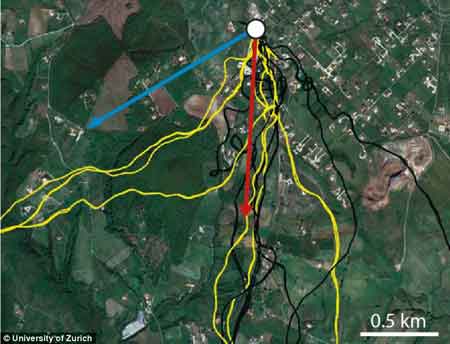當(dāng)前位置: Language Tips> 雙語新聞
Scientists discover pigeons have an in-built map in their heads
分享到
 |
|
藍(lán)箭頭指示喂食鴿房的方向,紅箭頭指示鴿房方向,白點(diǎn)為放飛地點(diǎn)。黃色表示饑餓鴿子的飛行路線,黑色表示喂過食鴿子的飛行路線。 |
|
The mystery of how a pigeon can always find its way back home has finally been solved. Scientists believe that pigeons have a spatial map that allows them to fly in an unfamiliar territory and know exactly where they are going. The finding replaces the current theory that pigeons compare the coordinates of their location with those of the home loft and then systematically reduce the difference between the two to find their way home. This earlier theory likens the navigation of pigeons to that of flying robots. But experiments carried out at the University of Zurich have shown that pigeons possess cognitive capabilities. In unknown areas, the scientists claim pigeons recognise where they are in relation to their home loft and are able to choose their targets themselves. Homing pigeons and migratory birds determine their flight direction with the help of the Earth’s magnetic field, the stars and the position of the sun. Nicole Blaser, a doctoral student in biology at the University of Zurich proposed the theory that pigeons have a spatial understanding and knowledge of their position in space relative to their home loft. This theory presupposes a type of mental map in their brain and thus cognitive capabilities. Up until now, there has not been any clear evidence to support this. For their experiments, Blaser and her colleagues fitted homing pigeons with miniature GPS loggers in order to monitor the birds’ flight paths. Beforehand the researchers trained the pigeons not to obtain food in the home loft, as was normally the case otherwise. ‘We fed the pigeons in a second loft around thirty kilometres away, from where they each had to fly back to their home loft’, said Blaser, explaining the structure of the experiment. The scientists then brought the pigeons to a third place unknown to the pigeons in completely unfamiliar territory. This release site was in turn 30 kilometres from the home loft and the food loft. Natural obstacles obscured visual contact between the release site and the two lofts. One group of the pigeons was allowed to eat before flying home. The other group was kept hungry before starting off. ‘We wanted to find out whether the hungry pigeons fly first to the home loft and from there to the food loft or whether they are able to fly directly to the food loft,’ said Blaser. ‘As we expected, the satiated pigeons flew directly to the home loft’, said professor Hans-Peter Lipp, neuroanatomist at the University of Zurich. ‘They already started on course for their loft and only deviated from that course for a short time to make topography-induced detours.’ The hungry pigeons behaved differently, setting off on course for the food loft from the very beginning and flying directly to that target. They also flew around topographical obstacles and then immediately adjusted again to their original course. Based on this evidence, Blaser believes that pigeons can determine their location and their direction of flight relative to the target and can choose between several targets. Blaser concluded that pigeons have a type of cognitive navigational map in their heads and have cognitive capabilities. ‘Pigeons use their heads to fly’, she said. |
據(jù)英國(guó)《每日郵報(bào)》7月26日?qǐng)?bào)道,瑞士蘇黎世大學(xué)的科學(xué)家經(jīng)過實(shí)驗(yàn)得出結(jié)論:鴿子大腦中有一幅空間地圖,因而能夠在陌生地區(qū)飛行,并能判斷出確切的飛行方向。 現(xiàn)有理論認(rèn)為,鴿子把自己所處的位置坐標(biāo)與家里的鴿房坐標(biāo)相比較,有條理地減小兩者之間的區(qū)別,進(jìn)而找到回家的路。以往的研究認(rèn)為,信鴿和候鳥在地球磁場(chǎng)、星星和太陽位置的幫助下確定飛行方向。而蘇黎世大學(xué)生物學(xué)博士尼科爾?布萊澤則提出新的理論:鴿子具有空間識(shí)別能力,知道自己相對(duì)于鴿房的空間位置。該理論預(yù)先假定鴿子的大腦中有一種意象圖,因而具有認(rèn)知能力。在此之前,沒有任何顯著證據(jù)支持這一理論。 在實(shí)驗(yàn)中,布萊澤和同事在信鴿身上安裝了微型GPS記錄器,以便監(jiān)測(cè)其飛行路線。 與以前的實(shí)驗(yàn)不同,研究人員預(yù)先訓(xùn)練鴿子不在自己的鴿房?jī)?nèi)獲取食物。“我們?cè)诖蠹s30公里外的另一個(gè)鴿房喂鴿子,每只鴿子都必須從那里飛回自己的鴿房,”布萊澤解釋說。接著,科學(xué)家把鴿子帶到距離鴿房和喂食鴿房30公里外的陌生地點(diǎn),讓自然障礙物模糊了放飛地點(diǎn)與這兩個(gè)鴿房之間的視覺接觸。 一組鴿子獲準(zhǔn)在回家之前吃東西。另一組鴿子則在出發(fā)前保持饑餓。布萊澤說:“我們想弄清楚,饑餓的鴿子是先飛到自己的鴿房再?gòu)哪抢镲w到喂食鴿房,還是可以直接飛到喂食鴿房。” “正如我們所料,吃飽的鴿子直接飛回了鴿房,”蘇黎世大學(xué)神經(jīng)解剖學(xué)教授漢斯-彼得?利普說,“它們已經(jīng)開始朝鴿房方向飛了,只是在地形誘導(dǎo)下,短時(shí)間偏離航線,繞了點(diǎn)路。”饑餓鴿子的行為則有所不同,它們從一開始就朝喂食鴿房的方向飛,直接飛向了目標(biāo)。 據(jù)此,布萊澤認(rèn)為鴿子可以確定自己的位置和相對(duì)于目標(biāo)的飛行方向,而且能夠在幾個(gè)目標(biāo)之間做出選擇。她由此得出結(jié)論,鴿子的腦袋里有一種認(rèn)知導(dǎo)航地圖,也具有認(rèn)識(shí)能力。 相關(guān)閱讀 衛(wèi)報(bào):白人學(xué)生不愿上大學(xué) (譯者 yuanlu 編輯 信蓮) |
上一篇 : 奧巴馬將在白宮與希拉里共進(jìn)午餐
下一篇 : 北極融化可能耗費(fèi)全球60萬億美元
分享到
關(guān)注和訂閱

關(guān)于我們 | 聯(lián)系方式 | 招聘信息
電話:8610-84883645
傳真:8610-84883500
Email: languagetips@chinadaily.com.cn